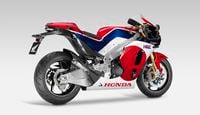It was easily the biggest story from the EICMA Motorcycle Expo—the long-overdue appearance of Honda's much-rumored, hugely anticipated street-legal MotoGP replica, the RC213V-S (see Honda Unveils RC213V-S Prototype At EICMA here). The bike was every bit as impressive under the lights as in our imaginations, finished in iconic red, white, and blue HRC Racing graphics and looking like it came straight from Motegi's pit lane, with the same silhouette as Marquez's World Championship-winning racer right down to the ginormous box-section swingarm and hand-welded, asymmetric dual exhaust. It was just what we asked for—the proverbial racebike with lights.
It was also the biggest disappointment of the EICMA show.
Honda might be the most capable motorcycle manufacturer in the world, but the RCV-S is a textbook example of phoning it in. There's no innovation involved in tacking turn signals and a bar-end mirror onto the existing RC213V, and nothing to suggest that even modest consideration was given to making this a satisfying streetbike. I could be wrong, of course, because Honda didn't divulge a single specification on this new "prototype"—only furthering the impression that this was a last-minute effort to quiet critics (like me) who claim that Honda lately doesn't care much about sportbikes.
I know what some of you are saying: What could possibly be better than a street-legal MotoGP bike? Well, anyone who has ridden Ducati's similar-concept Desmosedici will tell you it is one of the most brutal, uncomfortable, and difficult motorcycles for the average rider to master on the street or the racetrack. Then there's the issue of price: The rumor buzzing around EICMA suggested that should the RCV-S ever see production, it would sell for 170,000 euros (about $210,000)—making even the $75,000 Desmosedici seem dirt cheap in comparison. This isn't a serious attempt by Honda to advance superbike performance. It's a quickie parts-bin fix to make, what is at best, a mantelpiece for well-moneyed collectors.
Honda’s effort looked lazy in contrast to the all-new YZF-R1 on display at the Yamaha booth on the other side of the exhibition hall. The R1 uses just as much MotoGP technology as the RCV-S. In the case of the R1, however, all that technology has been painstakingly adapted to benefit average street and track riders, not just “alien” MotoGP stars. The flex characteristics of the frame are optimized for street tires at non-superhuman speeds; the power is as usable right off idle as at redline (so we’re told); the ergonomics are meant to work more than 45 minutes at a time; even the styling, which superficially resembles the M1, has been radically altered to be more dynamic than the plain, function-first racebike.
The day following the EICMA debut we visited Yamaha’s MotoGP workshop just outside Milan, where we had a candid discussion with racing manager Lin Jarvis about the close cooperation between Yamaha’s factory MotoGP team and the engineering staff in Japan and how that synergy directly benefits consumers. This latest R1 is the best example of this trickle-down technology we’ve seen yet, with innovations that actually serve the rider and improve the riding experience. Best of all, with a base price of just $16,490—a teeny-tiny fraction of what Honda’s RCV-S might cost—you can actually afford to own, ride, and enjoy the R1.
Yamaha's new YZF-R1 was not conceived quickly or carelessly—this is a MotoGP race replica done right. And this is what we sincerely wish Honda would have done with its outdated CBR1000RR, instead of distracting us with the shiny, essentially unobtanium RCV-S. So what if the RC213V-S offers more outright performance capability than the YZF-R1? Unless your name is Marc Marquez, the highly specialized performance advantages it offers won't mean anything to you. And good luck affording an RC213V-S, anyway, unless you're carrying Marquez's bank balance too.












/cloudfront-us-east-1.images.arcpublishing.com/octane/QSTCM6AVEZA5JJBUXNIQ3DSOF4.jpg)
/cloudfront-us-east-1.images.arcpublishing.com/octane/U4I7G625B5DMLF2DVIJDFZVV6M.jpg)
/cloudfront-us-east-1.images.arcpublishing.com/octane/B6XD6LS6IVCQPIU6HXDJSM3FHY.jpg)
/cloudfront-us-east-1.images.arcpublishing.com/octane/ICL63FEDDRDTTMINYICCEYGMDA.jpg)
/cloudfront-us-east-1.images.arcpublishing.com/octane/FCGZHQXRBZFLBAPC5SDIQLVF4I.jpg)
/cloudfront-us-east-1.images.arcpublishing.com/octane/WNOB6LDOIFFHJKPSVIWDYUGOPM.jpg)

/cloudfront-us-east-1.images.arcpublishing.com/octane/X33NU3E525ECRHXLNUJN2FTRKI.jpg)
/cloudfront-us-east-1.images.arcpublishing.com/octane/6KKT5NNL2JAVBOXMZYS5ZO76YA.jpg)
/cloudfront-us-east-1.images.arcpublishing.com/octane/J5RKG5O455GMPGQRF2OG6LRT7A.jpg)
/cloudfront-us-east-1.images.arcpublishing.com/octane/GX2CIZKQVRH2TATDM26KFG2DAE.jpg)
/cloudfront-us-east-1.images.arcpublishing.com/octane/ZWIDYSAKQZHD5BHREMQILXJCGM.jpg)
/cloudfront-us-east-1.images.arcpublishing.com/octane/CYUHJZCTSJCH3MRAQEIKXK7SCQ.jpg)
/cloudfront-us-east-1.images.arcpublishing.com/octane/LKOFINY56FCXJCANJ5M7ZDQUBY.jpg)
/cloudfront-us-east-1.images.arcpublishing.com/octane/4NBPDACMWJH63JQYJVK3QRBDZI.jpg)
/cloudfront-us-east-1.images.arcpublishing.com/octane/KKHQHRR3FJGX7H2IPU6RALMWG4.jpg)

/cloudfront-us-east-1.images.arcpublishing.com/octane/5IOFS5JAE5FOXMNA23ZRAVVYUU.jpg)
/cloudfront-us-east-1.images.arcpublishing.com/octane/CGXQ3O2VVJF7PGTYR3QICTLDLM.jpg)

/cloudfront-us-east-1.images.arcpublishing.com/octane/OQVCJOABCFC5NBEF2KIGRCV3XA.jpg)
/cloudfront-us-east-1.images.arcpublishing.com/octane/OPVQ7R4EFNCLRDPSQT4FBZCS2A.jpg)
/cloudfront-us-east-1.images.arcpublishing.com/octane/YBPFZBTAS5FJJBKOWC57QGEFDM.jpg)
/cloudfront-us-east-1.images.arcpublishing.com/octane/W5DVCJVUQVHZTN2DNYLI2UYW5U.jpg)